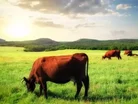The Importance of Drought Assistance for Livestock and Agricultural Producers

The droughts that have been plaguing agricultural areas in the United States are very real, and problematic to say the least. It’s not a problem confined to the agriculture sector, either – problems with crops affect a broad range of sectors from food processing to retail to energy, and rising commodity costs mean higher retail prices which affects the economy. It’s a chain reaction that demands attention.
This broad scope underscores the necessity of drought relief and long-term assistance programs for livestock and crop producers. The United States Department of Agriculture (USDA) has been rising to the challenge with a range of programs, working on its own and through its Natural Resources Conservation Service (NRCS) and local Farm Service Agency (FSA) outlets, to provide farmers with everything from education on water conservation to emergency land for haying and grazing livestock.
The sheer number of signups is proof positive of the necessity of such programs – according to a news release from the USDA, the department has received over 94,500 applications to date. But while it’s one thing to provide these services in theory, how are they working out in real world practice?
To take stock of its progress, the USDA checked in with LaNelle Martin – a small livestock rancher with 40 cows and 640 acres of pasture in crisis, who had signed up for disaster assistance in April through Nebraska’s Kimball County FSA outlet – to see how its program had helped in this instance. According to the report, Martin received 100 tons of hay and feed through the program, and was able to utilize Conservation Reserve Program (CRP) land for emergency grazing. Addressing the programs, Martin states that they helped keep her ranch from ending up financially underwater:
"The assistance has been a help for cash flow and to get back on track," said Martin who, along with her husband Dan, has been farming for about 10 years. "It gives us an opportunity to move ahead instead of feeling like we are behind."
As climate change continues to cause shifts in temperatures and available resources, it’s up to everyone with a hand in the industry to work together to find viable solutions. In the meantime, it’s good to see that programs are working to keep small businesses afloat.
[Read More: http://www.agweb.com/article/drought_assistance_helps_nebraska_rancher_get_back_on_track_NAA_News_Release/]



